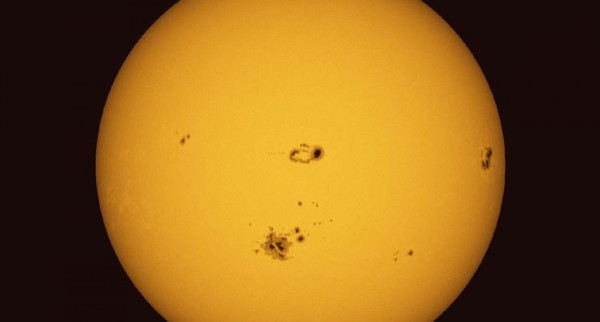Scientists Discover Way to Predict Sunspots Days Before Solar Eruptions

Researchers from Stanford University say they have discovered a way to forecast the emergence of sunspots before they reach the solar surface.
Sunspots develop in active solar regions of strong, concentrated magnetic fields and appear dark when they reach the surface of the sun. Eruptions of the intense magnetic flux leads to solar storms, but until now no one was able to predict them.
Now the researchers have developed a method that allows them to peer deep into the sun's interior by using acoustic waves to catch sunspots in the early stage of development and giving as much as two days' warning.
The findings documented in the recent edition of Science journal provides scientists a new mode of tracking the propagation of sound waves in the solar surface and thereby improve space weather forecast.
Many solar physicists tried different ways to predict when sunspots would appear, but with no success, said Phil Scherrer, a professor of physics in whose lab the research was done. He spoke via statement from the university.
The new method uses acoustic waves generated inside the sun by the turbulent motion of plasma and gases in constant motion. In the near-surface region, small-scale convection cells, which are about the size of California, generate sound waves that travel to the interior of the sun and are refracted back to the surface.
The researchers got some assistance from the Michelson Doppler Imager aboard NASA's Solar and Heliospheric Observatory satellite, known as SOHO. The craft spent some 15 years making detailed observations of the sound waves within the sun. It was superseded in 2010 with the launch of NASA's Solar Dynamics Observatory satellite, which carries the Helioseismic and Magnetic Imager, according to the university in a news release.
Stathis Ilonidis, a Stanford graduate student in physics and lead author of the paper on the research, used the data generated by the two imagers and was able to develop a way to reduce the electronic clutter in the data so he could accurately measure the solar sounds.
Ilonidis and his colleagues measured how long it takes sound waves to travel from one point on the solar surface to another, some 100,000 to 200,000 kilometers away, along a refracted, or bent, path through the interior.
They found that sound waves that would normally take an hour to cross from one point to the next traveled 12 to 16 seconds faster when a sun spot was emerging.
“We know enough about the structure of the sun that we can predict the travel path and travel time of an acoustic wave as it propagates through the interior of the sun. Travel times get perturbed if there are magnetic fields located along the wave's travel path,” said Junwei Zhao, a senior research scientist at Stanford's Hansen Experimental Physics Lab and study co-author.
The new method enabled Ilonidis to detect sunspots in the early stages of formation as deep as 40,000 miles inside the sun, between one and two days before they would appear on the sun's surface.
Researchers have suspected for a long time that sunspot regions are generated in the deep solar interior, but until now the emergence of these regions through the convection zone to the surface had gone undetected. We have now successfully detected them four times and tracked them moving upward at speeds between 1,000 and 2,000 kilometers per hour, ,Ilonidis said.
The new research could be extremely useful for those seeking to predict space weather events like solar storms in advance and thereby enabling people to prepare for them.
© Copyright IBTimes 2024. All rights reserved.





















